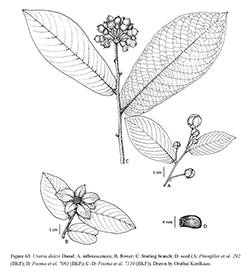e-Flora of Thailand
Volume 16 > Part 1 > Year 2022 > Page 300 > Annonaceae > Uvaria
7. Uvaria dulcis Dunalwfo-0001066093
Monogr. Anonac. 90 & t. 13. 1817.— Anomianthus dulcis (Dunal) J.Sinclair, Gard. Bull. Singapore 14: 40. 1953; Backer & Bakh. f., Fl. Java 1: 105. 1963; Hô, Câyco Viêtnam 1(1): 302. 1991. Fig. 63.
Accepted Name : This is currently accepted.
Synonyms & Citations :
Description : Sarmentose shrub or climber up to 30 m long or more. Young shoots tomentose, becoming glabrous with distinctive pale lenticels. Leaves membranous, elliptic to broadly elliptic to shortly obovate, ca 10–14 by 4.5–6 cm, base sub-cordate to shortly cordate, apex acute, blade sparsely covered with 1–4-branched spreading hairs or becoming subglabrous, tomentose with erect hairs along the sunken midrib above, blade sub-tomentose except with spreading 5+-branched hairs, tomentose near petiole, on veins and midrib the hairs ca 10-branched, ferrugineous, and stocky below, secondary veins 15–18 per side; petioles 3.5–5 by ca 1 mm, tomentose. Inflorescences terminal, pendulous, 1–many-flowered, usually 2–3-flowered, peduncle ca 5–10 mm, pedicels ca 12–25 mm; buds globose. Sepals 3, valvate, connate at base, ovate-acute, ca 3.25 by 4.5 mm. Petals in two whorls of 3, white or yellow-pink, broadly elliptic-acute at first, expanding to obovate-acute at maturity, coriaceous to membranous; outer petals ca 21.5 by 11.5 mm; inner petals ca 20.5 by 10.5 mm, inner surface basally glabrous with two lateral orange-coloured glands inserted above the base. Stamens numerous, cuneate, ca 1.5 mm long, anther connective apex broad and flattened, often forming lip on inner side, papillate, glabrous, locules often uneven in length, filament short. Carpels ca 25, forming a distinct dome above stamens, ca 2.5 mm long, usually hairy below stigma neck and along lateral ridges, stigmas long and hairy with distinct neck, U-shaped; ovules ca 14–16. Monocarps ca 10+, green turning orange and then red, oblongoid to short-cylindrical, ca 1 by 0.65 cm, glabrous, stipe ca 5–10 mm. Seeds 1–8, compressed-ovoid, ca 5 by 4 by 4 mm, perichalazal ring raised, aril transversely compressed.
Thailand : NORTHERN: Mae Hong Son, Chiang Mai, Chiang Rai, Lamphun, Sukhothai; NORTH-EASTERN: Sakon Nakhon; EASTERN: Chaiyaphum, Surin, Si Sa Ket, Ubon Ratchathani; SOUTH-WESTERN: Prachuap Khiri Khan; CENTRAL: Saraburi, Nakhom Pathom, Nakhon Nayok; SOUTH-EASTERN: Chon Buri.
Distribution : Laos, Cambodia, Vietnam, Java (type).
Ecology : Uvaria dulcis is often found in scrub vegetation, however it is most common in disturbed forests in the low-rainfall zones of North-eastern Thailand, sea level to 700 m alt. Flowering: March–December; fruiting: April–January.
Vernacular : Khruea nom ngua (เครือนมงัว)(Northern); manom ngua (มะนมงัว); nom maeo (นมแมว), nom maeo son (นมแมวซ้อน), nom wua (นมวัว)(Northern); tin tang (ตีนตั่ง), top hu (ตบหู), (Ubon Ratchathani); tin tang noi (ตีนตั่งน้อย)(Nakhon Phanom).
Notes: The membranous obovate petals with conspicuous lateral glands on the inner whorl distinguish this species within the genus.

